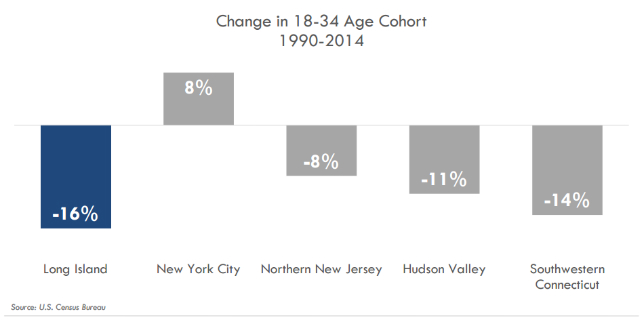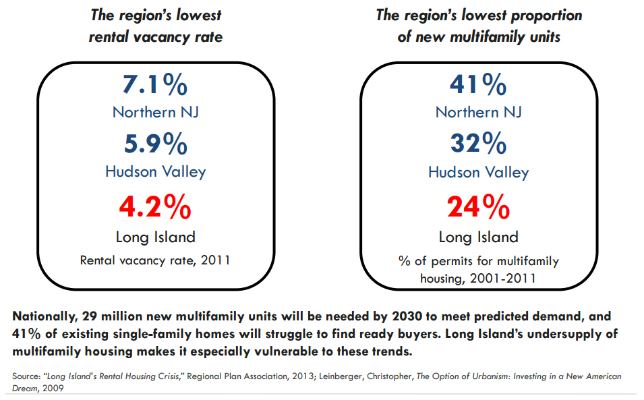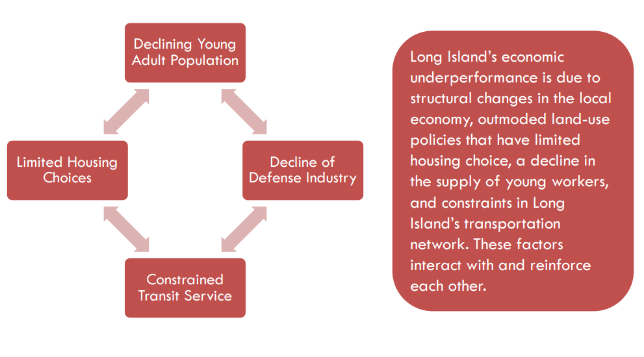Rauch Foundation Releases Latest Long Island Index Report; Are We better Off Then We Were A Year Ago?
Long Island, NY - Feb. 23, 2016 - The Rauch Foundation recently released their Long Island Index report, an annual endeavor – which they note “tracks progress on key regional economic and community indicators” – whose current edition takes an in-depth look at date pertaining to multiple aspects of the Long Island region, including housing, schools, the so-called “Third Track” project, and the overall economic climate. The goal, as stated on the Long Island Index website, is “to be a catalyst for action, by engaging the community in thinking about our region and our future.”
And it’s that very future that we’re going to take a look at in this article, and how that latest Long Island Index report is anticipating that future to play out. The simple question we’re hoping to answer by taking a look at the Long Island Index is- are we better off as Long Islanders than we were a year ago?
Unfortunately, that fails to be a cut-and-dry answer. Those wondering if we’re coming to the end of the phenomenon known as the “Brain Drain” – the phrase attributed in recent years to the massive departure of youth graduating from college from Long Island due to the lack of employment opportunities – will have to wonder for a bit longer; certain aspects of life on Long Island have certainly improved in the past 365 days, but not enough to stem the flow of our best and brightest to greener pastures, unfortunately.

The Long Island Index report points out that as of a 2015 study, 26 percent of Long Island adults between the ages of 18 and 34 live at home with their parents, and virtually all of them do so due to lack of affordable housing; 60 percent of Long Islanders surveyed across a wide range of age groups, incomes, and education levels noted that housing was a serious issue, more so than among residents of other areas in New York State.
“I’m in the Marines right now, so I don’t have to worry, but when my tour of duty is over and I come home to Long Island, I have no idea if I’ll be able to afford to live here,” said Michael Heckman, a Massapequa resident who has a young fiancé waiting for him at home. “After I get home and get married, we’ll probably have to move somewhere else unless we can find jobs here that pay enough. It’s hard out there.”
Long Island Index notes that 72 percent of residents surveyed said that young people leaving Long Island is an “extremely serious” problem; in contrast, just 44 percent of NJ residents share this concern about their young people leaving, driving home just how bad things are getting on Long Island. And while one of the solutions that the Long Island Index proposes to counter the issue is to build more housing and rental units en masse, which they claim will drive down the cost of living; however, a recent article written by Rich Murdocco of the Long Island Press counters that claim, noting that the creation of more housing units in the boroughs of Queens, Brooklyn, and Manhattan failed to make them any more affordable. More realistically, Murdocco said, affordable housing units are made via tax subsidies utilized by public-private partnerships.

Schooling is another hot button topic amongst local residents. The population of Long Island is very diverse along ethnic lines; however, according to the Long Island Index, the same cannot be said about its school districts. In their report, they note that while the overall student body of Long Island was comprised of 61 percent white students and 39 percent from ethnic and racial minority groups, 90 percent of schools considered to be in high-poverty areas had student bodies that were made up of Black (30 percent) or Hispanic (60 percent) attendees. This stands in opposition to more financially well-off school districts, where the vast majority of students were either White or Asian.

Also, the Long Island Index report notes that the highest poverty school districts continue to see the economic downturn of their residents grow worse as opposed to better; clearly, many of the families of their student bodies are moving to these areas not because they want to, but because they have no other alternative. And this increasing level of poverty is further increasing the reliance on assistance programs such as free lunch; Long Island Index notes that, in 2013, over 63% of students attending high-poverty schools were receiving free lunch.
What makes things all the harder for school districts on Long Island are a number of recent happenings within New York State that have made it more difficult for school districts to maintain their current level of programming and staffing. In 2011, New York Governor Andrew Cuomo enacted a two percent tax cap upon property tax in part to attempt to curb significant annual school tax hikes for residents within their respective school districts; these tax hikes have been in part due to regular cuts in state aid to schools over many years, in addition to regular unfunded mandates handed down by the state legislature.
While the tax cap – which limits the amount that local governments and school districts can increase property taxes to the lower of two percent or the rate of inflation – has given taxpayers a small respite from their financial burden, this has left many school districts on Long Island – and indeed, state-wide – in the difficult position of having to find creative ways to generate revenue to support the programs and staff that their students depend upon, especially in light of the rise of unfunded mandates from the state. Indeed, education on Long Island is facing an uphill battle in many ways, despite school taxes being considered quite high by many residents, including Jack Fitzpatrick, a father of three from Levittown.
“It’s absurd, how much comes out of my pocket for school taxes,” he said. “Education is important, anyone knows that, but the taxes are so high that I know my kids will probably never be able to afford to live here. They’re already talking about moving to someplace cheaper to live like South Carolina once they finish school, which will break my wife’s heart. But really, I can’t blame all the kids leaving Long Island…the cost of living is insane here.”
It’s an attitude that many parents share; while Long Island is very desirable to live on for a vast number of reasons, many people are being priced out, and one of the many financial hurdles faced by people both young and old are school and property taxes, which are among the highest in the nation. But while older residents may be entrenched and weathering the storm, younger people just starting their lives will continue to leave for better possibilities – both in terms of the cost of living and the job market – until a financial equilibrium is brought about.

Another aspect of the Long Island Index report is an in-depth examination of New York Governor Andrew Cuomo’s recently proposed “Third Track” project –an expansion of the Long Island Rail Road (LIRR). The proposed additional Long Island Rail Road track is slated to cover a ten-mile route from Floral Park to Hicksville, but despite the numerous benefits of the project being touted by Governor Cuomo –including reduced congestion and improved workday commutes – a number of local municipalities surrounding the Third Track route are in direct opposition and very vocal to it.
Mayors of incorporated villages such as Floral Park, Stewart Manor, Mineola, and New Hyde Park have joined up with New York State Senator Jack Martins in an effort to thwart the Third Track proposal. Some of the issues these individuals and their constituents have voiced about the project were laid bare at a recent public Board of Trustees meeting by Stewart Manor Mayor Gerard S. Tangredi.
“There has been a lack of information being communicated to municipalities involved during the proposal’s early stages, and the project is currently slated to utilize environmental impact data that was gathered five years ago for a previous attempt at a Third Track…this information is now out of date,” he said. “Plus, there’s the impact to the villages themselves…increased traffic from the railroad crossings themselves…I mean you can’t get across the local crossings as it is now, and with additional trains it will be worse. Plus, there are a number of schools along the tracks.”
Another ally of the villages opposed to the Third Track is U.S. Congresswoman Kathleen Rice; according to Thomas Tweedy, Mayor of Floral Park, he and other local leaders had met with Rice, who would be acting as a liaison of sorts between the affected municipalities Metro Transit Authority (MTA), who is set to head up the Third Track project.
“Kathleen Rice said that she would be meeting with the Metro Transit Authority (MTA) and share our concerns with them,” he said. “Then she will meet with us again, after which our strategy going forward would be determined.”
But while opposition to the Third Track project have expressed quite valid concerns regarding its implementation, it’s possible benefits also cannot be ignored, either. The Long Island Index report notes that in 2011, 25 percent of personal income for Long Island residents – totaling $26 billion dollars – was earned at jobs in Manhattan. And of that number, one-third of those workers commuted daily on the LIRR. The Long Island Index points out that it would take ten new highway lanes to carry the equivalent number of people to and from Penn Station on a daily basis.
Clearly, careers in New York City are prevalent amongst Long Island residents, and a Third Track would increase the efficiency of their commute – especially at peak transit times, where estimates cut wait time between trains in many instances in half – and possibly even increase the allure of working in the city for workers who are on the fence regarding the prospect traipsing back and forth in overcrowded trains every day.

The Third Track project would also provide an economic boon to Long Islanders; the Long Island Index report says that it will provide 2,250 annual construction jobs during the build phase, in addition to 14,000 permanent jobs by 2035.
With both its good points and bad, it remains to be seen if the municipalities opposing the Third Track can hash out their differences with Governor Cuomo and the LIRR so that their concerns can be addressed while allowing the Third Track project to go forward; a previous attempt at revamping the LIRR in such a manner along the same route five years ago was halted by a similar show of opposition.
And all of this leads to the central aspect that all of the aforementioned issues of Long Island in this article revolves around- the economy. The fact is that the region needs more companies that can provide well-paying jobs, and an expansion of jobs offered from existing companies. The Long Island Index report is hopeful that an emphasis on small technology companies can jump-start things in the region, particularly ones that can take advantage of Small Business Research and Innovation (SBIR) the Small Business Technology Transfer (STTR) programs that provide funding to small technology companies of less than 500 employees.
Noting that Long Island is “home to world-class research centers at its nationally recognized laboratories and research universities,” and that “Long Island has more innovation strengths than is often recognized and that the region has the potential to become a leading innovator if it uses its assets more effectively,” the Long Island Index puts forward the viewpoint that “greater entrepreneurship and business innovation in the region’s leading industries of bioscience, information technology and clean energy,” are among the factors that can improve Long Island’s economy. However, this fails to take into account a way to generate more well-paying jobs for blue-collar residents; perhaps creating programs that provide tax incentives for companies that do not outsource jobs to other areas is a way to help in that regard.
The Rauch Foundation’s Long Island Index can be an invaluable tool for not only measuring the current status of living conditions on Long Island and where we can expect them to go in the upcoming year, but for identifying weak spots that we as a community need to address as well. However, while it is not the end-all, be-all as far as economic barometers go, it does make an excellent point- things are hard on Long Island these days, and thing have to change. Innovation and entrepreneurship in business is needed, as well as affordable housing and – most importantly – jobs. Without these, our youth will continue to leave the area in greater numbers, and eventually the things Long Island needs to bounce back will dry up entirely.
So, are we better off than we were a year ago? The short, easy answer is no; however, Long Island possesses the tools and the talent to march bravely into a bright and productive future.
